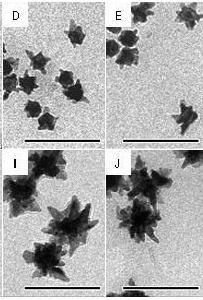Tiny gold stars, smaller than a billionth of a meter, may give rise to new approaches for medical diagnosis or examining the environment and identifying the pollutants in it

Rods, cones, cubes and spheres - clear the way! Tiny gold stars, smaller than a billionth of a meter, may give rise to new approaches for medical diagnosis or examining the environment and identifying the pollutants within it.
While nanoparticles have become a hot topic in a wide variety of sciences, new research conducted by bioengineers at Duke University indicates that of all the structures examined so far, the star structure has the greatest advantage for certain applications.
The key factor is light, and especially how it is reflected out of the particles. The Duke University researchers found that compared to other structures, nanostars are able to significantly increase the reflected light. This fact increases their ability to be used as a tracer, label or contrast agent.
Because the researchers also found that the exact size and shape of the nanostars affects the spectrum of the reflected radiation, they believe it will be possible to tune the nature of these tiny nanostars so that they can recognize and bind to specific compounds and chemicals.
"To our knowledge, this is the first paper on the development and use of gold nanoparticles as tags for molecular recognition and the first description of their controlled preparation with different sizes and shapes," said Chris Khoury, lead author of the paper published in the online version of the journal Physical Chemistry.
Duke University's experiments used nanostars in combination with a phenomenon first described in the seventies and known as "surface-enhanced Raman scattering" (SERS). When light or radiation, usually from a laser source, is directed towards a material sample, the target compounds vibrate in response and emit radiation at a wavelength unique to them, known as Raman scattering. When the target compound is conjugated to a nanoparticle or metallic nanostructure, the Raman response is significantly increased due to this effect - sometimes even a million times.
In the early eighties, the researcher Vo-Dinh and his colleagues were among the first to demonstrate that this phenomenon can be used for practical applications such as the identification of chemicals, including: carcinogens, environmental pollutants and initial symptoms of diseases. Now at Duke University, the researcher is pushing the limits of this technology by designing a variety of types and shapes of metallic nanoparticles that could be used as tags for chemical and biomedical diagnostics.
"We are trying to understand what kind of nanostructures will provide us with the best signal so that we can use it to monitor tiny amounts of pollutants or to diagnose diseases in their initial stages," said the researcher. "This research is the first demonstration that these nanostars can increase the effect of the Raman phenomenon to obtain a strong and unique spectral "signature", like an "optical fingerprint".
The researchers "grew" the nanostars by mixing tiny gold particle "seeds" in a suitable solution. As more gold particles were added to the solution, new protrusions began to develop outward from the direction of the particle core. Addition of gold increased the size of the entire particle.
"These experiments prove that the size and shape of the nanostars can be changed in a controlled manner by adjusting the volume of the gold seeds added to the growth solution," said researcher Khoury. "We found that changes in the size of the star affected the nature of the reflected radiation, a fact that suggests that the results obtained from this phenomenon can be adjusted."
For this type of research, or those that exist in the fields of environmental contamination, it will be possible to bind a dye compound to the nanostars and mix them with the sample being tested. Or then the sample will be placed under a microscope and you will receive a decent dose of laser energy. Sensors will be able to record the Raman scattering pattern and interpret the unique optical imprint of the sample.
The researcher points out that the nanostars are small enough to penetrate the walls of living cells so that they can be used in practical applications of molecular diagnostics. Nanostars will be able to bind to antibodies to search for antigens suitable for them, or bind to dyes to improve the efficiency of various imaging tests.
Although the element silver increases the measurement more broadly, the researchers specifically chose the element gold because it is a stable metal that does not stimulate the immune response in the body. Unlike silver, gold does not oxidize within the samples.
The research group at Duke University is currently developing innovative methods for chemical detection and medical diagnosis using these nanostars. The lead researcher explains that since each tag compound has its own unique optical fingerprint, theoretically it would be possible to produce a single detector that could detect a collection of different types of cancer, for example, or completely different environmental pollutants.

One response
Prof. Abdulhalim of Ben-Gurion deals with this fascinating subject.